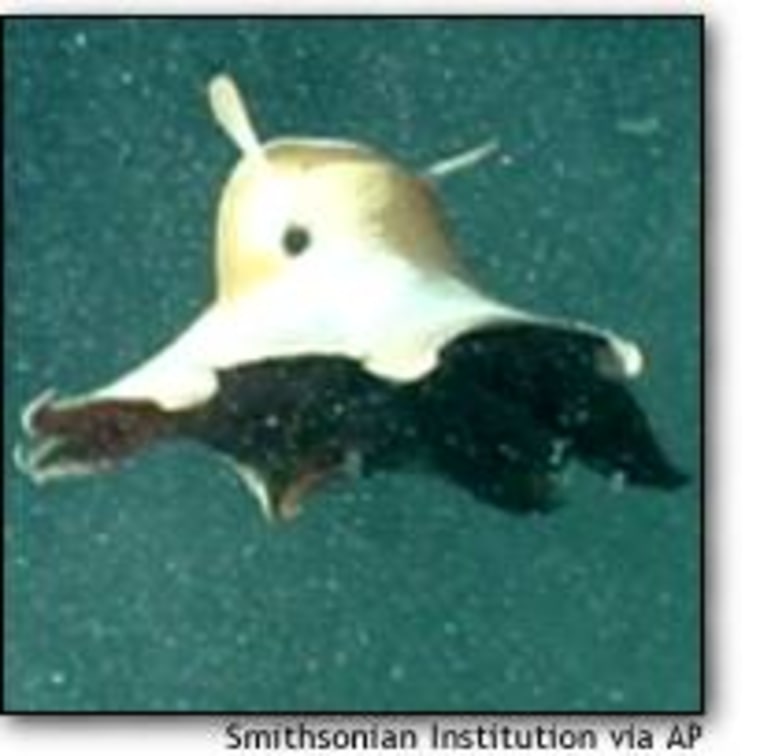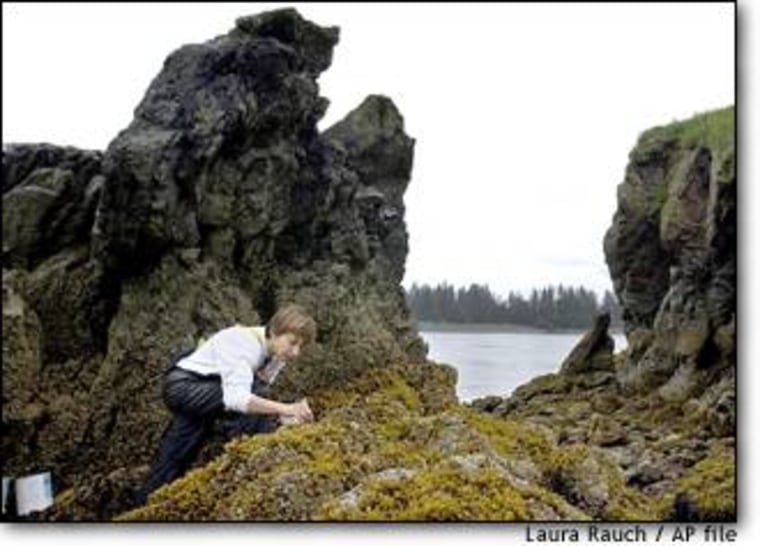Brenda Konar shoots an anxious glance over her shoulder but keeps chiseling. The Pacific Ocean hasn’t gone away. In fact, it’s gaining on her. Wedged between slimy boulders, the marine biologist hacks at the crusty stuff clinging to the ragged shoreline of the Kenai Peninsula. Frigid seawater seeps through the duct tape patch on her rubber waders. Her knuckles bleed.
Soon, the world's second-largest tides will submerge this speck called Cohen’s Island, located 250 miles southwest of Anchorage.
“We’re in so much trouble,” Konar mutters into the wind and rain.
Halfway around the world, Mike Vecchione shudders as Russian deckhands slap the metal hull of his tiny submarine. In any language, that echo means “Good to go!”
To where? Two slow, dark miles to the bottom of the North Atlantic, to a spot disconcertingly named the “Charley Gibbs Fracture Zone.” The pressure down there would crumple a truck.
The Smithsonian biologist curls on a cushion as a crane dangles his vessel over the ocean like a drip from a faucet.
“I can’t believe I’m doing this,” he whispers.
Field studies first
From pole to pole, in virtually every ocean, scientists from two dozen nations are wrapping up preliminary field studies. Together the studies will serve as the foundation for the most extensive project of its kind — the Census of Marine Life.
The census seeks a fundamental understanding of all life that relies on the largely unexplored seas covering most of Earth, increasingly beleaguered by pollution, overfishing and climate change.
This unprecedented field guide to millions of species is supposed to be completed in 10 years. It could cost as much as $1 billion, much of it funded by the Alfred P. Sloan Foundation and governments.
It’s a staggering budget. But it’s a fraction of the $55 billion seafood trade or what it costs to clean up a major oil spill.
The census is divided into seven topics. Besides Pacific shorelines and the North Atlantic sea floor, scientists are examining the Gulf of Maine, hydrothermal vents, coastal salmon runs, the worldwide habits of large fish and mammals, and animals of the abyss.
“We’re asking scientists to think beyond their own quarter-mile of beach,” said Ronald O’Dor, a Nova Scotia squid expert who has moved to Washington to coordinate the census. “We don’t know what we’ll find. We don’t even know what we are looking for.”
Info for everyone
Scientists expect the census will shed new light on Earth’s fundamental processes, like evolution and climate. But others expect it will serve more practical purposes.
Environmentalists will use it to identify threatened species and locations for marine parks. Fishing and shipping interests believe the observations will make them more efficient — and profitable. And bio-prospectors hope the census will yield a bounty of new materials and compounds, ranging from medicines to industrial adhesives.

The census begins in earnest at a time when the ocean’s bounty suddenly appears alarmingly skimpy. Large fish have been depleted by 90 percent since World War II.
“People think of space being the final frontier, but most of our planet is very poorly known,” Vecchione said. “You can’t protect something that you don’t understand and you can’t use something that you haven’t inventoried.”
Fish-taggers see results
So far, the most startling results have come from the fish-taggers.
Biologists attach digital instruments to the backs of the oceans’ most athletic swimmers and fearsome hunters. Known collectively as pelagics, these sharks, tuna, humpback whales, elephant seals, Humboldt squid, even sea turtles are tracked by satellite on their mysterious journeys.
Early data from 700 Atlantic bluefin tuna demonstrate that fish from different regions commingle freely during migrations ranging from the Texas coast to the Mediterranean.
The results smash assumptions that bluefin populations never mix, and that fleets can intensively harvest particular regions, such as the Flemish Cap off Canada, without harming stocks throughout the hemisphere.
The stakes are huge. Globally, 3 million tons of tuna are processed annually. A single bluefin weighs more than an NFL lineman and fetches $175,000 at Tokyo’s seafood market.
But the bluefin population has been plummeting since the 1980s. International commissions already are using tagging data to establish more restrictive quotas globally.
Beginning this fall, scientists will begin tracking thousands of additional pelagics to address broader scientific questions.
Among them: In the vastness of the oceans, does marine life scatter or does it behave similarly to terrestrial life and congregate?
Early tagging data suggests some surprising similarities.
“There are hints of shared corridors that different animals are using and places they will loiter, like watering holes,” said biologist Randy Kochevar of the Monterey Bay Aquarium.
12-hour drive
But none would follow Vecchione nearly 10,000 feet down to the Charley Gibbs Fracture Zone.
He scrunches against a tiny porthole to watch bizarre, gelatinous creatures of the Very Deep drift by.
It is Vecchione’s ninth dive, but his first to this extreme depth — and the first by anyone to the Charley Gibbs. It’s a spur of the Mid-Atlantic Ridge, the mountainous undersea spine where continental plates bump and grind, forming new crust.
A dive lasts more than 12 hours, including long stretches in utter darkness to conserve battery power. Occasionally, the path is weirdly marked by the pink and blue fireworks of bioluminescent phytoplankton.
Vecchione’s sub drifts down sheer cliff faces and crests lava hills. It’s a Precambrian aquarium teeming with life forms that emerged 600 million years ago.
Sampling it is dicey because the creatures’ fluid-filled body sacs often explode. So Vecchione relies on video.
He spots a primitive octopus drifting like a rubbery hand puppet; an orange frogfish lurching on primordial fin-legs; a U-shaped worm wriggling in the muck and sporting a purple growth like a boutonniere.
Vecchione’s reconnaissance will keep him busy all winter identifying “mystery animals.” But it’s bad news for fishing boats that must venture ever further.
“The bottom is even rougher than expected,” he reports. “It is not at all trawlable.”
Samples galore
In Alaska, shoreline studies by Konar and her research partner, Katrin Iken, wrestle with the opposite problem: too many samples.
The University of Alaska biologists laboriously sample Cohen’s and Elephant islands in the bay with the help of a dozen students.
Others will use similar methods to examine shorelines in Russia, Japan, Thailand, Chile and Antarctica.
Most of the world’s population and industry are crowded along coastlines, so when catastrophe strikes, those regions suffer the most.
Again, high stakes. Exxon spent $9 billion trying to clean 1,500 miles of coastline after the Exxon Valdez spilled 11 million gallons of crude oil in Prince William Sound.
During high tide at Kachemak Bay, Konar and Iken scuba-dive about 30 feet down to where life always is submerged. “We pull up laundry bags full of kelp,” Konar says.
At low tide, the steep slopes of little islands are exposed throughout the bay. They reveal distinct layers — barnacles and mussels up high, followed by red algae, brown algae and the crown of the kelp.
At each layer, the biologists isolate sections of exposed rocks with a square-meter frame of white plastic pipe. Iken photographs each square.
They kneel and count every living thing inside the frame. The women scrape all of it into a pail, then repeat the process dozens of times.
Within minutes, the tide and the storm swallow their sites. After a punishing boat ride back to the mainland, the real census work begins.
Tiny catch, big picture
Late into the chilly night, Konar and Iken record their catch under the glaring lights of a laboratory shed. Much of it resembles what’s rotting at the bottom of your refrigerator. The women keep the door and windows open, and their coats zipped.
“I’m not separating the little soranthera from the odonthalia,” Konar scowls, flicking at a stubborn seaweed shred on her sleeve.
Iken dumps another pail of Kachemak salad on the table, giggling.
Hours drag. A scratchy clock radio plays oldies.
“I like the big picture,” Iken says, waving tweezers and spinning her census dream. “I want to compare this with a site in California. And Chile.
“And did you know that nobody is working on gelatinous bioplankton?”
Konar nods. At her elbow rest 20 more buckets.
Through the open door, they can hear the tide racing out again.
More about the Census of Marine Life is online at .
